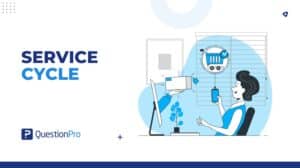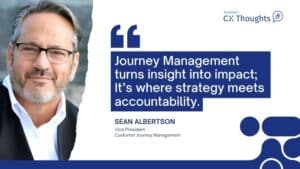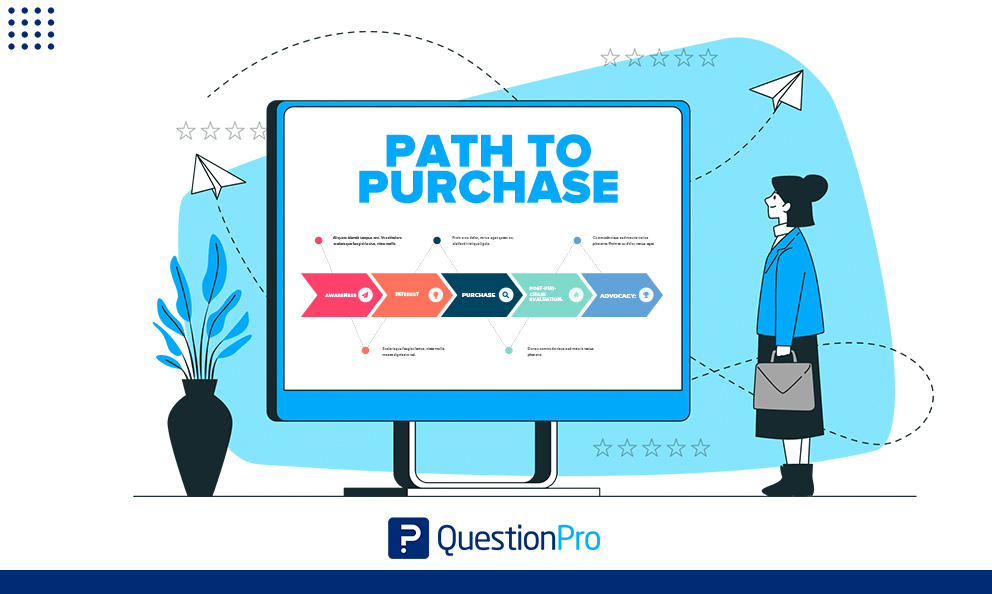
Your business constantly seeks ways to comprehend and optimize your journey from initial awareness to purchasing. This journey, often called your path to purchase, is an important element of your marketing strategy and sales optimization.
In this blog post, we will dive into what your path to purchase entails, explore its various stages, and emphasize the significance of data analysis in navigating this intricate terrain.
What is the Path to Purchase?
The Path to Purchase, or the Customer Journey or Sales Funnel, is the journey you embark on when purchasing. It takes you through different stages and touchpoints, from the moment you become aware of a product or service to the final purchase and beyond.
Understanding the various touchpoints in the customer journey, from awareness through loyalty, is essential for businesses to strategically implement effective marketing strategies and optimize the path to purchase institute. This journey is crucial for companies to effectively engage, tailor marketing efforts, and optimize the overall customer experience.
The Importance of Tracking the Path to Purchase
Tracking the path to purchase is crucial in any market. Understanding how we move from initial awareness to making a purchase provides valuable insights that can improve marketing strategies and the overall experience to drive business success.
Here are several reasons highlighting the importance of tracking your path to purchase:
- Gain Behavioral Insights: Self-awareness of your purchasing behavior allows you to make more conscious decisions and understand your preferences. Recognizing influential touchpoints helps you filter and prioritize information, leading to more efficient decision-making.
- Optimize Marketing Strategies: It’s important to carefully consider where you focus your attention and allocate your resources. Knowing which channels speak to you the most is crucial for cutting through the noise and improving on the content that genuinely holds significance.
- Personalized Customer Experience: Knowing your buying process stage allows you to appreciate and engage with personalized content and interactions. Recognizing efforts businesses or consumer brand marketers make to tailor experiences fosters a stronger connection and loyalty.
- Identify Pain Points: By acknowledging friction points in the shopper journey, you become better equipped to provide feedback and seek solutions. This awareness can contribute to the improvement of overall customer experiences, benefiting both consumers and businesses.
- Attribution Modeling: Understanding how you attribute value to different customer touchpoints helps you make more informed decisions about where to focus your attention and resources.
- Forecasting and Planning: Recognizing patterns in your purchasing behavior empowers you to plan and budget more effectively. Anticipating future needs based on your past behavior aids in making proactive and strategic decisions.
- Customer Retention and Loyalty: As a consumer, recognizing efforts made by businesses for post-sale engagement allows you to appreciate and engage with loyalty programs and recommendations. Acknowledging the value of follow-up communication contributes to a positive cycle of engagement and retention.
- Adapting to Changing Trends: Self-awareness of your evolving behavior enables you to stay ahead of trends and adapt to changes in the market. This adaptability positions you as a more informed and agile consumer.
Stages in the Path to Purchase
The path to purchase, or customer journey, involves steps consumers take in deciding to buy. Understanding these stages helps businesses tailor strategies for effective engagement and conversion. The common framework includes:
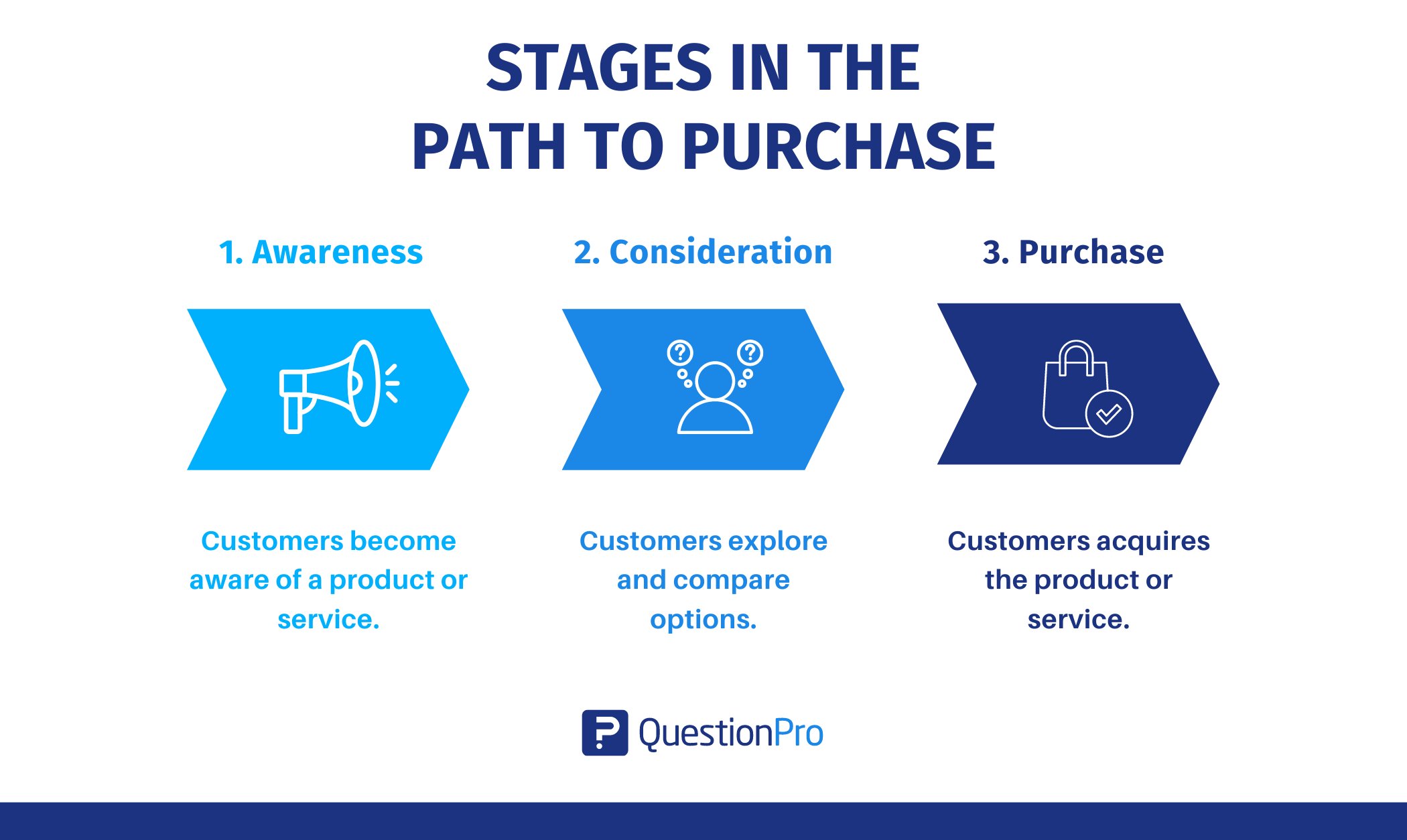
1. Building Awareness
In the initial stage of your journey, the primary goal is to build awareness among potential customers. This involves making you aware of a brand, product, or service. Key strategies of the awareness stage include:
- Content Marketing: Engage with informative content to showcase a brand and address your pain points.
- Social Media Presence: Experience brands reaching out on social media platforms to connect with a broader audience, share content, and interact with you.
- Search Engine Optimization (SEO): Encounter optimized online content, making it easier to discover specific brands through search engine results.
- Advertising: Notice targeted advertising campaigns tailored to reach your demographic and increase brand visibility.
2. Consideration Strategies
Once awareness is established, the focus shifts to providing information to consider a product or service. Strategies for you in this consideration stage include:
- Educational Content: Access in-depth content highlighting a product or service’s features, benefits, and unique selling points.
- Customer Testimonials: Read testimonials and reviews from satisfied customers to build trust and credibility.
- Email Marketing: Receive targeted email campaigns nurturing your interest and providing additional information.
- Comparison Guides: Explore content comparing products or services, aiding you in making well-informed decisions.
3. Mastering the Purchase Phase
Now, the focus is on guiding you toward making a transaction. Strategies for you in this final stage include:
- Clear Call-to-Action (CTA): Encountering websites and marketing materials featuring clear and compelling CTAs designed to guide you toward making a purchase.
- Simplified Checkout Process: Experience a streamlined purchase path process, minimizing friction and making completing transactions easy.
- Special Offers and Incentives: Receive discounts, promotions, or exclusive offers tailored to incentivize your immediate purchase.
- Trust Signals: Notice trust symbols, secure payment options, and transparent policies to instill confidence in your purchase decision.
- Post-Purchase Support: Benefit from excellent customer support, order tracking, and follow-up communication to enhance your buying experience.
Exploring Post-Purchase Stages
Once you make a purchase, you enter the post-purchase stages. Your journey involves navigating through the steps crucial for businesses like yours to build customer loyalty, encourage repeat purchases, and foster positive word-of-mouth. Here, we outline the key post-purchase stages:
1. Retention Tactics
After you’ve made a successful purchase, businesses focus on retaining you as a potential customer and encouraging repeat business. Key strategies in this stage include:
- Loyalty Programs: Joining loyalty programs offering rewards, discounts, or exclusive perks for repeat purchases.
- Personalized Communication: Receiving personalized communication, such as targeted emails or offers based on your previous interactions and preferences.
- Customer Feedback: Providing opportunities to share feedback, helping businesses understand your experience and address concerns.
- Continuous Engagement: Ongoing engagement through newsletters, updates, or relevant content aims to keep the brand top-of-mind for you.
2. Cultivating Advocacy
In this stage, businesses aim to turn your satisfaction into advocacy, where you actively promote the brand. Strategies for cultivating advocacy include:
- Referral Programs: Encouraging you to refer friends or family with incentives such as discounts or bonuses for both parties.
- User-Generated Content: Encouraging you to share your experiences through social media, reviews, or testimonials, showcasing real-life use cases.
- Community Building: Creating a community or forum where you can connect, share experiences, and become a brand ambassador.
- Social Proof: Social proof showcases satisfied customers’ positive experiences and testimonials to build credibility and trust among potential buyers.
Influential Factors in the Path to Purchase
Recognizing what influences your journey from initial awareness to making a purchase provides you with valuable insights that can shape your buying behavior and guide your decision-making process.
Here are several factors that play a significant role in influencing your path to purchase:
Influence on Your B2C and B2B Purchases
In B2C, impulse buying is a significant factor, while various reasons influence B2B purchases and may involve multiple decision-makers within your organization. The factors impacting B2B purchases are diverse and can affect different decision-makers differently.
Building Reputation and Credibility
Your reputation and credibility are crucial factors for you as a B2B buyer. Pay more for services with a proven track record rather than risking experimentation. You likely research an organization’s reviews, policies, certifications, and compliance with regulations to assess their credibility.
Harnessing Referrals and Word-of-Mouth
Trust is paramount in your B2B decision-making. Referrals play a significant role in influencing your B2B purchases. Positive word-of-mouth recommendations and showcasing case studies and testimonials can enhance credibility in your eyes.
The Role of Presales and Support
Customer support is vital throughout your B2B sales process, both before and after the sale. A robust presales and support system can impact your decision-making process. You prefer to buy from those with strong support systems, as it instills confidence that your needs will be met.
Building Relationships and Retaining You as a Customer
Positive experiences with customer support can lead to favorable reviews and enhance the likelihood of you choosing a product or service. Ongoing communication and assistance through a strong support system can make your path to purchase more predictable and contribute to your satisfaction and retention as a customer.
| We also recommend you read: B2B Buyer Journey
Crucial Data Points for Tracking the Path to Purchase
Understanding your journey from discovery to purchase is essential for optimizing your business strategy. You can gain valuable insights into your consumer behavior by honing in on specific data points. Here are key elements for you to consider when tracking your path to purchase:
01. Source and Referrer Insights
- Examine where your website traffic originates.
- Identify the sources and referrers that drive the most conversions.
- Understand the effectiveness of various shopper marketing channels in attracting potential customers.
02. Analyzing Your Page Visits and App Interactions
- Track your interactions with our website pages and mobile apps.
- Identify the pages, ad platforms, review sites, and features that capture your interest.
- Analyze the duration of your visits to understand your engagement levels.
03. Identifying Your Entry Points
- Determine the entry points through which you first engage with our brand.
- Understand which channels and touchpoints contribute most to your initial awareness.
- Optimize entry points for maximum impact on your path to purchase.
04. Measuring Your Website Content Engagement
- Assess the effectiveness of our website content in keeping you engaged.
- Analyze your bounce rates and time spent on key pages.
- Optimize content to align with your preferences and expectations.
05. Assessing Your Email Engagement
- Track your email open rates, click-through rates, and conversion rates.
- Evaluate the performance of different email campaigns.
- Tailor future email content based on insights gathered from your engagement.
06. Checkpoints for Your Business
- Establish specific checkpoints in your customer journey for evaluation.
- Monitor your progression through these checkpoints.
- Implement strategic adjustments based on the data gathered at each stage.
Getting through the path to purchase isn’t always easy. Your business can face challenges that need smart solutions to make sure your customers have a smooth and good experience. Now, let’s explore the major challenges that lie ahead and explore effective ways to overcome them.
Tackling Long Customer Journeys
Customer journeys can be long and complicated. Path to purchase involves three main steps to turn someone into a customer. At each of these steps, there can be many interactions or touchpoints. It’s tough for your business to keep customers interested from when they first hear about a product to when they decide to buy it.
Knowing and dealing with all the different points along the way is really important to keep your customers happy.
Customers can engage through different channels, and keeping track of all of them accurately is really hard. With so many digital channels, customers expect a smooth experience wherever they interact.
Navigating omni-channel engagement is a challenge. Your business has to make online and offline interactions work well together. To do this, you need to keep a consistent brand, message, and experience across all the different channels.
If you have a website, then you can easily keep track of everything that happens on your website. By using UTM parameters and referrer data, you can trace activities like emails, social media interactions, and third-party engagements. If social media is crucial for you, consider using a social media tracking solution to monitor engagement.
Unifying Data Sources
Data is super important for your marketing and keeping your customers engaged. But, it can be tough to put together data from different places. When your data is all over the place, it’s hard to really understand your path to purchase.
Your business needs to work on bringing all your data together, breaking down barriers between different sources, and using strong analytics to get useful insights from the whole customer journey.
How to Conduct a Path to Purchase Analysis
Conducting path to purchase analysis is key for understanding your customer journey, from recognizing a need or desire to making that final purchase decision. This research method is your compass, systematically unraveling customer behaviors to illuminate pivotal touchpoints and decision-making processes.
01. Surveying Customers at Key Points
One approach to conducting a path to purchase analysis is through targeted surveys. By reaching out to customers after significant milestones, such as post-purchase or after leaving a review, businesses can glean valuable insights.
These surveys offer a direct channel to understand customer sentiments, preferences, and any challenges faced during their journey.
02. In-Depth Customer Interviews
Interviewing customers adds a valuable qualitative aspect to the analysis. By exploring the customer’s purchase journey through engaging conversations, businesses have the opportunity to discover complex details.
These insights go beyond quantitative metrics, which offer a deeper understanding of the emotional and cognitive factors that shape customer choices.
03. Tracking Brand Awareness Metrics
Understanding the importance of brand awareness is crucial in the journey toward a path to purchase. Keeping an eye on metrics such as website traffic and conversion rates gives you valuable insights into how well your brand is performing and how visible it is to your audience.
Brand awareness metrics are crucial for measuring the effectiveness of marketing efforts. It allows businesses to fine-tune their strategies using up-to-date data.
04. Exploring the Potential of Behavior Data
Analytical platforms provide valuable data insights for a path to purchase analysis. Your businesses can identify patterns, preferences, and pain points by analyzing customer behavior data. Insights extracted from platforms contribute to a holistic understanding of the customer journey, which guides strategic decision-making.
05. Essential Metrics to Track
It’s important to keep an eye on a few key metrics when analyzing website performance. These include click-through rates, conversions, bounce rates, and the amount of time visitors spend on the site. These metrics serve as important indicators, pointing out potential areas where customers might lose interest or face challenges.
With this valuable information in hand, your businesses can have the power to enhance their websites and marketing strategies proactively. It leads the way for a more smoother path to purchase.
Maximizing Path to Purchase for Customer Acquisition
People expect a lot from the brands they interact with. Brands need to provide personalized experiences when customers need them. As customers go through different stages in their buying process, they look for all kinds of information, from good to not-so-good reviews.
Smart marketers can use these small moments to teach customers about their products and get them interested in the brand.
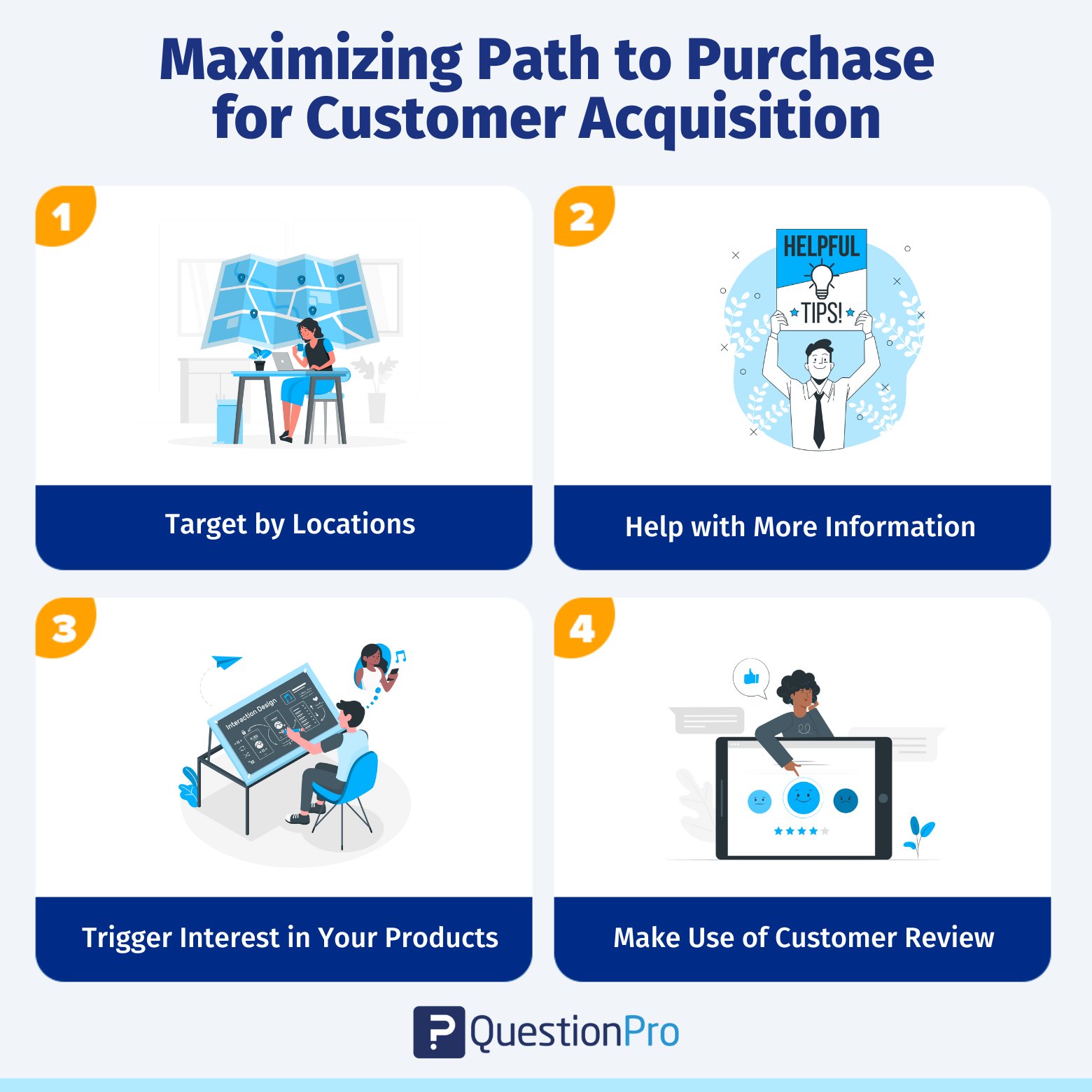
Target by Locations
Tailor your approach to reach customers where they are. Take advantage of the increasing popularity of location-based searches. Make sure your brand is well-optimized to offer value and convenience, especially when users are looking for products or services nearby.
Help Customers with More Information
Empower your customers by offering in-depth information about your products and services. Be a valuable resource during their decision-making process. It provides transparent and authentic details that guide them toward informed choices.
Think What Else Could Trigger Interest in Your Products
Consider the various factors that can capture attention and generate interest in your products beyond the initial search. Explore unique factors that can attract potential customers to your brand. Identify connections between your products and related categories to engage a wider audience.
Make Use of Customer Review
Utilize the power of customer reviews in shaping purchasing decisions. Showcase positive feedback and ratings on your website, advertisements, and messaging to build trust. Let the experiences of satisfied customers guide and reassure potential buyers, fostering confidence in your brand and products.
Path to Purchase vs. Customer Journey
When distinguishing between the Path to Purchase and the Customer Journey, it’s vital not to confuse the two.
- Path to Purchase: This happens beyond a brand’s control and involves the channels customers use before making a purchase decision.
- Customer Journey: Specifically refers to the total experience a customer gets when purchasing a product or using a service from a specific brand. This journey enables the brand to track interactions, measure conversion rates, and provide insights for improving your entire experience.
| Path to Purchase | Customer Journey |
| Awareness | Discovery |
| Consideration | Research |
| Purchase | Evaluation |
| Post-Purchase | Decision |
| Advocacy | Loyalty |
Tracking the Path to Purchase with QuestionPro
When it comes to understanding how customers make decisions, using the right tools is key. QuestionPro is a handy solution for businesses that can follow and analyze the journey customers take before buying something.
Here’s how QuestionPro makes it easy for you to track this crucial journey:
- Customized Surveys for Your Business: You can create surveys that fit each stage of your customer’s buying process. Ask questions that matter, getting insights into your customer’s preferences, challenges, and what drives their decisions.
- Keep Tabs on Every Way Your Customers Connect: Your customers can engage with you through various channels, online and offline. QuestionPro helps you track these interactions across different touchpoints, giving you a full picture of how your customers engage with your brand.
- Real-time Insights for Quick Decisions: You can get real-time customer journey analytics to see how your customers are behaving as it happens. Act on insights promptly, adjusting your strategies on the fly to keep up with the changing path to purchase.
- Seamless Integration with Your Tools: QuestionPro easily fits in with your other business tools and platforms. Consolidate data from various sources, making sure you have a clear understanding of your customer’s entire journey.
- Turn Data into Actionable Insights: QuestionPro doesn’t just collect data; it helps you understand what it all means. You can use the insights to make informed decisions at every step of your customer’s path to purchase.
Why QuestionPro is Right for You?
- Easy to Use: QuestionPro is made so that anyone can use it easily. Businesses don’t need to be super tech-savvy to make it work.
- Scalability: Whether a business is just starting or has been around for a while, QuestionPro can adjust to fit the needs of the business as it grows.
- Actionable Insights: QuestionPro doesn’t just collect data – it helps businesses understand what the data means. This way, businesses can make smart choices at every step of the buying journey.
QuestionPro is your partner in understanding and optimizing the path to purchase. It empowers you to gather meaningful information, adapt to your customer’s behaviors, and enhance their journey toward successful conversions.
Try it today to enhance your understanding of customer experiences.
Frequently Asked Questions (FAQ)
The “path to purchase” refers to the journey that a consumer takes from initial awareness of a product or service to making a purchase decision. It typically involves stages such as awareness, consideration, and decision, reflecting the steps a customer goes through before making a buying choice.
The buyer’s path to purchase, also known as the customer journey, consists of several stages that individuals typically go through before making a purchase. These stages can vary, but a common framework includes:
Awareness: The consumer becomes aware of a need or desire for a product or service.
Consideration: The individual researches and evaluates different options to fulfill their need. This may involve comparing features, prices, and reviews.
Intent: The consumer expresses a clear intention to purchase and may start looking for specific sellers or retailers.
Purchase: The actual transaction takes place, and the consumer acquires the chosen product or service.
Post-Purchase Evaluation: The consumer assesses their satisfaction with the product or service after the purchase. This stage influences future buying decisions and brand loyalty.
Understanding and mapping the buyer’s path to purchase is crucial for businesses to tailor their marketing strategies and provide relevant information at each stage, ultimately guiding the consumer toward making a purchase.
Post-purchase evaluation involves assessing satisfaction with the product or service. It is crucial for understanding customer feedback, addressing issues, and building long-term relationships.
Loyalty often results from positive post-purchase experiences. Repeat purchases, brand advocacy, and positive word-of-mouth contribute to customer loyalty.





